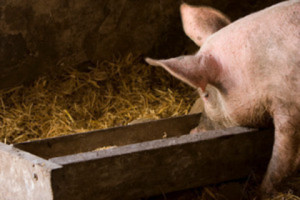Scientists and regulators investigating the mysterious spread of a deadly virus plaguing the U.S. pork industry are stepping up their scrutiny of what the nation’s hog herd eats.
With a dearth of solid leads, investigators are exploring whether something in pig feed could be a conduit for porcine epidemic diarrhea virus, which has spread to 27 states and killed millions of young pigs since it was first identified in the U.S. last  April. One focus of the inquiry: porcine plasma, a widely used feed ingredient made from the blood of slaughtered hogs and fed to piglets.
April. One focus of the inquiry: porcine plasma, a widely used feed ingredient made from the blood of slaughtered hogs and fed to piglets.
Scientists say the virus, one of the most devastating diseases to afflict U.S. livestock in years, is fatal only to young pigs, and poses no threat to human health or food safety. But it has rapidly increased costs for major hog-farm operators, such as Smithfield Foods Inc. and Maschoffs LLC, as prices for replacement pigs have soared to new highs.
Porcine plasma has been a mainstay of piglet diets in the U.S. since the 1990s, after scientists discovered it provided antibodies to protect young pigs from disease and helped them switch from feeding from their mother to the grain-heavy diet common on livestock farms.
Last month, the Canadian Food Inspection Agency disclosed that it had found plasma contaminated with the virus, after multiple hog farms in Ontario that were hit by PED, and another farm on Prince Edward Island with a suspected case, all reported that they bought feed from the same vendor, Ontario-based Grand Valley Fortifiers.
The Canadian agency said that the virus was present in plasma that originated in the U.S. and was obtained at the company that manufactured Grand Valley’s feed, which the agency has declined to identify. It said the plasma contained virus “capable of causing disease in pigs.”
Porcine plasma is one of more than 40 ingredients in typical piglet feed. “Many people think that feed is the most likely suspect,” said Greg Stevenson, a veterinary pathologist at Iowa State University who has studied the virus. “But practically speaking, we have no proof.”
Porcine plasma is made from blood captured in chilled vats at slaughterhouses. It is treated with an anticoagulant and spun in a centrifuge to separate the plasma from blood cells, then transported in insulated trucks to processing plants. The plasma is shot through a spray nozzle into a heated chamber to evaporate excess water, leaving a powder that is run through stainless-steel dryers, bagged and shipped to feed companies.
